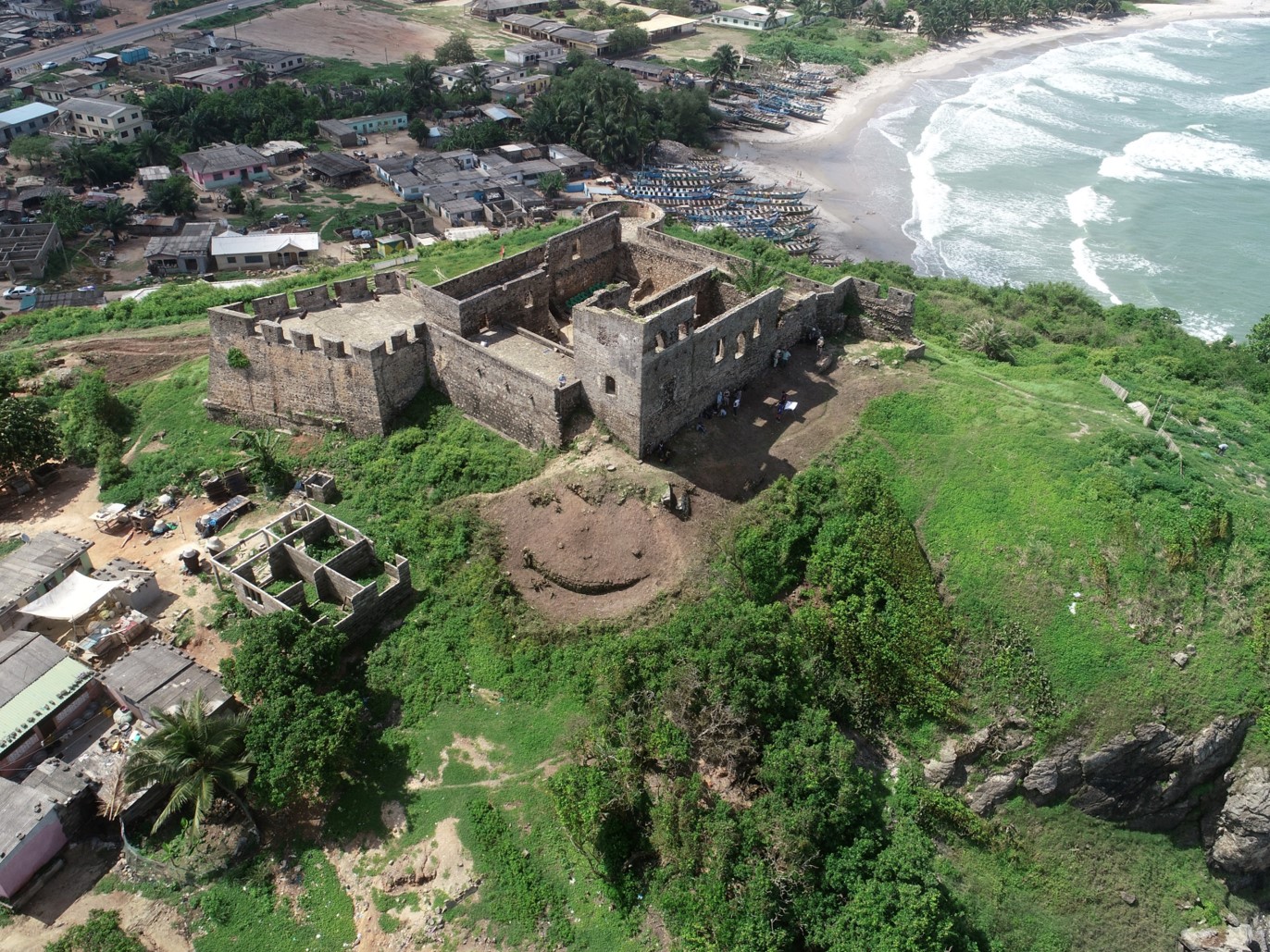In June 2019, Dr. Christopher DeCorse supervised Ghanaian and American students in conducting the first large-scale excavation at Fort Amsterdam since AW Lawrence’s work in the 1950s. The dig’s aim was to help assess the structural integrity of Fort Amsterdam’s ruins (since an NGO was contemplating rebuilding the fort’s houses), locating original foundations of the collapsed south curtain wall and southwest round bastion, and seeking traces of English Castle Cormantine, the predecessor of Dutch Fort Amsterdam. (MORE ON OUTCOMES)
The Global COVID-19 Pandemic halted archaeological research until June 2023, when Dr. DeCorse returned with a new team of Syracuse archaeologists and local community excavators in search of English Kormantin’s footprint and associated material culture. (MORE)
rchaeologists use material culture to understand and interpret the past. This includes features – buildings, ruins, trenches, roads, landscapes – as well as artifacts recovered from soil layers, which archaeologists methodically record in order to analyze changes over time, evidence of past human activities, alternations of local environments, and sites’ long-distance connections made through trade, war, migration, communication, and national or imperial integration.
Kormantin was an important node in European commercial and imperial expansion and West African participation in global trade and regional and imperial politics. As a meeting site for European and African traders, Kormantin was a conduit for material goods – gold, brass, iron, textiles, humans. As an English and Dutch company outpost surrounded by Fante residents who participated and facilitated in this trade, Kormantin was an international multicultural community in which local, regional, and international interactions were daily occurrences across three centuries. Kormantin Castle and Fort Amsterdam were themselves hybrid cultural object – defensive works made to protect goods and people following the latest European designs but built with African material and labor and modified to suit a tropical environment. Archaeological research thus has potential to help us understand how different European sojourners – company agents, craftsmen, soldiers – lived, adapted, and died at one particular global periphery, how the Fante people of “Little Kormantin” shaped and were shaped by their role as intermediaries linking inland African traders with Atlantic markets, and how global economic trends and wars created and affected the Kormantin community over the past five hundred years.
Despite its historical importance and profound research potential, very little archaeology has been done in and around Kormantin and Fort Amsterdam. After its destruction and abandonment around 1811, Fort Amsterdam remained a ruin while villagers rebuilt Abandze on the site of Little Kormantin and engaged in subsistence fishing to support themselves after losing its role as a trading site. Abandze remained a forgotten backwater until the 1950s, when British archaeologists noted its significance and worked to clear and stabilize the ruined fort’s shell. A.W. Lawrence directed a large-scale scouring of the fort’s interior and consolidated exterior walls, which essentially rebuilt the fort’s round northeast tower. Focused solely on structural elements, Lawrence unfortunately paid no attention to artifacts and other finds within the fill he removed nor did he map or otherwise record his substantial site modifications. In the early 1970s, African-American expatriate Robert Lee personally supervised other like-minded African Americans in restoring Fort Amsterdam but conducted no excavations.
J. Boachie-Ansah (2008) conducted the first professionally sophisticated archaeological excavations in Fort Amsterdam in April 2006 to assess an Italian NGO proposal to rebuild the fort’s interior structures in 2003 and address erosion concerns. Excavating in arbitrary 20cm layers, Boachie-Ansah’s four test pits revealed that the site has experienced considerable stratigraphic disturbance but included numerous seventeenth- and eighteenth-century artifacts, including locally made pottery, Chinese and Dutch ceramics, Dutch tobacco pipes and case bottles, glass stemware, roofing tiles, shells, faunal remains and other reflections of local diet. In his analysis, Boachie-Ansah argues that the fort was likely not occupied after 1811 based on the near-complete absence of typical nineteenth-century material culture and notes that the assemblage is overwhelmingly Dutch or Continental European in nature. At least in the areas he excavated, the site yielded no evidence of its initial 1631-1665 English occupation.
The following year, E. Kofi Agorsah and Thomas Butler (2008) made an archaeological test survey of the historic hilltop site of Great Kormantin (present-day Kormantse) a mile northeast of Fort Amsterdam. Situated in an area of considerable galamsay disturbance, Agorsah and Butler’s excavations yielded numerous local pottery sherds and trade goods ranging from glass beads and cowrie shells to tobacco pipes and European glass and ceramics – much of it dating to the nineteenth century (Agorsah, n.d. [2011]). Although Agorsah asserts that the first English trade lodge was built at his site rather than on Fort Amsterdam’s promontory, he presents no convincing historical or archaeological evidence to support this theory. In creating an artifact assemblage that can be connected to and compared with that of nearby Little Kormantin/Abandze, the Agorsah-Butler excavation makes a valuable contribution to future study of the Greater Kormantin area – if their collection can be located and made accessible
.
For a general overview of archaeological research in Ghana over the past century, see
Christopher DeCorse, An Archaeology of Elmina: Africans and Europeans on the Gold Coast, 1400-1900 (Blackwell, rev. ed. 2022), 4-6.
Agorsah, E. Kofi and Thomas Butler. 2008. “Archaeological Investigations of Historic Kormantse, Ghana: Cultural Identities,” African Diaspora Archaeology Newsletter 11.3, 1-22
Agorsah, E. Kofi. n.d. [2011]. Historic Kormantse. Cape Coast, Ghana.
Boachie-Ansah, J. 2008. “Excavations at Fort Amsterdam, Abandze, Central Region, Ghana,” in Current Archaeological Research in Ghana, Oxford: Archaeopress, 37-61


